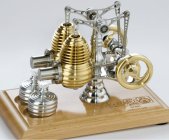Stirling engine

Just about one hundredyears ago, internal combustion engines hardly competed to take a place, which they have now in the up-to-date auto industry. Those days their superioritywas not so obvious as nowadays. In fact, the steam engine was the main rival of the gasoline unit, which had enormous advantages: noiselessness, easypower control, excellent traction performance and amazing “pantophagy” allowing to use any fuel from wood to gasoline. Finally, efficiency, lightweight and reliability of internal combustion engines got the better and forced to accept their disadvantages as the inevitable.
Inthe 1950s, since the appearance of gas turbines and rotary engines, there was a storm of monopolistic position occupied by the internal combustion engines in the automotive industry, the storm has been still unsuccessful. Approximately at the same period, there were some attempts to produce a new engine, which combined efficiency and reliability of the gasoline engine with noiselessnessand “pantophagy” of the steam unit. It was the famous external combustion engine patented by the Scottish priest Robert Stirling on September 27, 1816 (British patent No. 4081).
The main principle of all heat enginesis based on while the expansion of heated gas there is big mechanical work made than the expansion of cold gas. To demonstrate it, there will be enough a bottle and two pots with hot and cold water. First, the bottle is dropped into the cold water, when the air inside is cooler, the beak is corked and quicklytransferred into the hot water. In afew seconds, we can hear a clap when the heated gas in the bottle pushes the cork making the mechanical work. Then, wecanreturnthebottleinto the cold water and the cyclewillrepeat.
In cylinders, pistons and intricate levels of the first Stirling engine there was the almost similar process reproduced until the inventor did not realize that a part of heating taking from the gas while cooling might be used for partial heating. Only a container is needed to keep the heating taken from the gas when cooling and give back when heating.
Unfortunately, even that important improvement could not save the Stirling engine. By 1885, the achieved results were quite mediocre: 5-7 per cent of coefficient of efficiency, 2 hp of the power, 4 tons of weight and 21 cubic meter of occupied space.
The external combustion engineswere not saved by even the success of another design, developed by the Swedish engineer Erickson. In contrast to Stirling, he suggested to heat and cool then gas with not a constant volumebut the constant pressure. In 1887, several thousand small Ericson engines worked well in print shops, houses, mines and on ships.They filled water-pressure tanks, operated elevators. Erickson even tried to adapt them to drive crews, but they were too heavy for that.


Go Motors Blog
Top 10 Best Chevrolet Models of All Time
9 Unique Ways to Customize Your Car
How to Find the Best Tow Truck Companies
How to Diagnose Severe Car Problems (Even When You Don’t Know Anything About Cars)
6 Effective Maintenance Tips for Car Headlights
5 Tips for Finding a Good Mechanic You Can Trust
7 Driving Techniques and Other Tips for Fuel Efficiency
7 Tips for How to Install Windshield Wipers
The Most Valuable Parts on a Car to Scrap
View All Recent Posts
-
Three Methods to Make Purchasing a Business Car Easy and Cost-Effective
-
How an Auto History Check will Protect you From Fraudulent Sellers
-
The Financial Benefits of Short Term Car Insurance for Business Users